► Are these the best drivers’ Porsches ever?
► 718 Cayman GT4 RS vs 911 GT3 RS 4.0
► Watch our video twin test, read the review
Visit the Yorkshire seaside town of Whitby and you’ll see signs in nearly every fish and chip shop there: ‘Voted Best Fish and Chips in the World 2019!’ one will say. ‘Best in The World 2018!’ the next will boast. ‘Best Fish and Chips in the UK!’; ‘Winner, Best in Europe 2020!’; ‘Best in Whitby!’; ‘Best in Yorkshire!!!’. Basically everyone in town has won something. Accolades are as cheap as chips.
Supercars are like that: there’s always the fastest, the most expensive, the winner of this group test, the winner of that award. It’s easy to become jaded by the barrage of plaudits and praise.
But every once in a while a car comes along that really stands out – one that garners such incredible reviews it makes you sit up and pay attention. The Porsche 718 Cayman GT4 RS is one of those cars: at its international launch back in March, the press went nuts for the new RS. ’The stuff of dreams,’ one reviewer gushed. ‘One of the all-time greats!’ wrote another. ‘The best car I’ve ever driven,’ raved one experienced writer. Another waxed, ‘This could be the greatest driver’s car Porsche has ever built.’
Wow. This isn’t your basic ‘Best in Yorkshire’ stuff – this is next-level religious zeal. I mean, either the journalists all lost their minds driving from the airport in Nissan Leaf rental cars, or maybe the 718 Cayman GT4 RS really is the best sports car in the world right now? (By the way, I’m just going to refer to it as ‘the 718’ from now on, because typing the full name is making my fingers hurt.)
So, we decided to put this alleged ‘stuff-of-dreams’ greatness to the test, by comparing the new 718 to the actual car that I actually think actually is, officially and actually, the Actual Best All-Time Greatest Ever Made. Yes, it’s also an RS and it too has a stupidly long name: it’s the Porsche 911 GT3 RS 4.0. (Which from now on I am going to refer to as… ‘the 4.0’.) We all deserve to know where we stand, and finding out is a fitting way to celebrate Porsche’s position at number one in our three-issue CAR 60 countdown. (‘Voted Best Car Maker in Yorkshire – and the world!’)
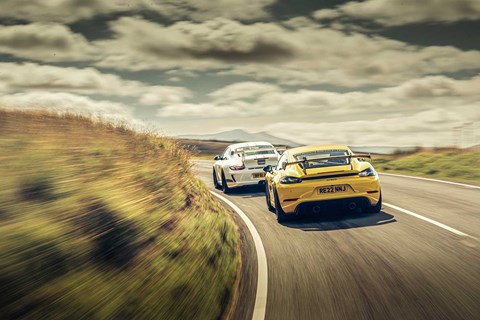
Launched in 2011, the 4.0 was the last of the 997-series 911s – a final flourish before the 991 was launched at that year’s Frankfurt motor show. Along with the slight engine-capacity increase over the standard 3.8-litre GT3 RS at the time, the 4.0 also featured better aero, revised suspension and lots of carbon parts to reduce the weight to just 1360kg. Limited to a production run of 600 cars, it also represented the end of an era for the 911: it was the last with hydraulic steering, before the 991 went to a fully electric rack; and the 4.0 was the last firework-extravaganza for the legendary Mezger engine, the liquid-cooled flat-six named after engine designer Hans Mezger, related to the 959 and GT1 Le Mans engine of 1996, and the power unit of choice for all GT3s up to that point.
I drove a 4.0 years ago and it has stayed with me ever since, like some kind of hallucinogenic trip. No exaggeration: within 100 metres of pulling away I knew; there’s some special voodoo about this car, the liquid nature of its movements, the intense feedback through the seat and the steering wheel, even at low speeds. It’s like my brain was running a bare palm along the tarmac, absorbing ever crack and fissure, every speck of grit.
And that engine! Free-revving and torquey, at 493bhp it was the most powerful normally-aspirated engine ever fitted to a 911 at the time, and it makes an intoxicating racecar howl. With its decals, the chin spoiler, the big rear wing, the 4.0 had everything – which is why it enjoys such cult status now. It also explains why left-hand-drive examples are upwards of £300k, and a rare right-hand-drive car like this – one of only around 30 in the UK – sold for £430,000 last year.
Porsche 911 GT3 RS 4.0 vs Porsche 718 Cayman GT4 RS twin test
So, some serious competition for the 718; and you may say it’s unfair to compare a Cayman to a 911? But frankly don’t blame me. All that flowery praise at the launch didn’t just call the new GT4 RS ‘the best Cayman of 2022’. They all said it’s the best Porsche, the best RS, the best sports car, the BEST THING EVER in the whole history of THINGS. Well, now the time for loose talk is over…
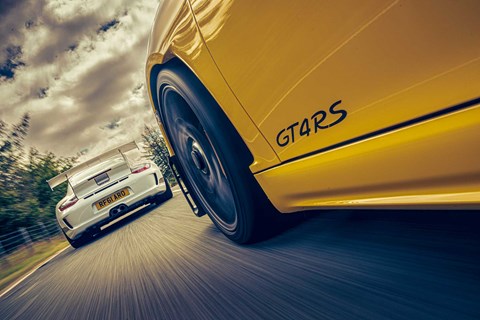
In the metal, our bright yellow 718 GT4 RS looks purposeful like a military-spec weapon – all wings, holes, louvres and scoops, it looks like something the US army might fire out of a bazooka, This example is fitted with lots of options, including the £11k Weissach pack that accounts for the exposed-carbon bonnet and titanium rollcage. Altogether, this car would set you back £133,500, up from the £108k base – making it eye-wateringly expensive compared to a ‘regular’ GT4 (£81k before options).
But then the RS is a significantly different beast. Like the black bonnet, the car’s front wings and that giant, swan-neck rear wing are also made from carbonfibre-reinforced plastic. Add in thinner rear-window glass and lightweight carpets, door panels and one-piece bucket seats and the GT4 RS weighs 35kg less than the regular GT4. (Though at 1415kg, that just shows how impressive the bigger 911 GT3 4.0 is – it is 50kg lighter still.) But the biggest change compared to the regular 718 GT4 is this new Cayman RS is fitted with the 911 GT3 engine.
Though it’s a completely different generation of flat-six, the specs are surprisingly similar to our 2011 GT3: so the 718 also has a 4.0-litre engine (confusing) that puts out an identical 493bhp; while the torque figure of 332lb ft is just 7lb ft less than the 911’s. The biggest difference (apart from small things like they’re utterly different models from different eras and the engines are mounted in different places) is the gearbox. While our 911 RS 4.0 is fitted with a six-speed manual, the 718 RS is fitted with a revised PDK paddleshift with shorter gearing for faster acceleration. It’ll do 0-62mph in just 3.4 seconds – compared to the 4.0’s 3.8 seconds.
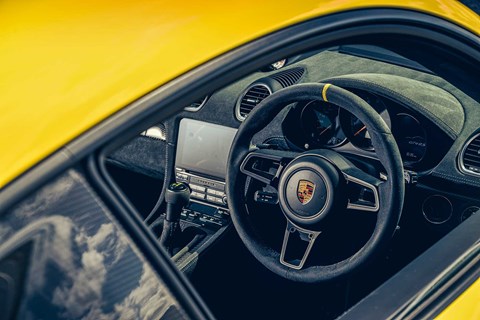
Climb into the 718 and you find yourself sitting bolt upright in the fixed bucket seats, hugged all the way up your sides from knee to shoulder. It feels serious, like you’ve just strapped yourself into a NASA rocket. The steering wheel is thin-rimmed and strangely flat, compared to a more ergonomically shaped Ferrari wheel, but don’t worry – when you start the engine you won’t care about any of that.
Because this is one of the craziest, loudest, most manic-sounding cars I’ve ever driven. At low speeds the engine just burbles and you mostly hear road noise from the big Michelin Cup tyres; but press the accelerator and a hard, resonating din erupts in your ears. And this sound isn’t remote, coming from somewhere deep in the engine bay – it’s right there, in the cabin, in your head, so loud you have to shout to be heard.
C’mon, feel the noise
Controlling this noise becomes one of the key pleasures of this car. Basically you’re playing a musical instrument with your right foot: look at the side of the car and you’ll see Porsche moved the RS’s air intakes to the rear quarter-light windows, which in turn feed an airbox sitting on top of that mid-engined flat-six, right behind your head. Much of the sound you hear is air, resonating through pipes like a bassoon or an oboe with some Porsche flat-six chatter playing in support. As you climb through the revs, you unleash a whole range of sucking, gulping, gasping, roaring, bellowing and blaring noises. Above 3000rpm it’s a hollow growl. From 5000rpm it’s a coarse dog yelp. And the last 1000rpm to 9000 is a piercing, demonic shriek, like a washing machine in an out-of-control spin cycle.
In a lot of modern performance cars, reaching a stratospheric 9000rpm redline is almost impossible because everything is so fast these days you run out of road. But the 718’s lower gearing and outrageously sorted chassis means you can actually exploit this engine. In fact, I’d say to a greater degree than the modern GT3 donor car. The 718 gives you such confidence: all the controls are so precisely measured. The ride is firm but never untidy over bumps. The steering is so direct and linear the car feels razor sharp and alert. With your hands fixed at a quarter-to-three on the wheel, fingers on the paddles behind, you just brake as late as you dare, aim it through the bend, then play on that throttle to unleash the noise.
This point-and-squirt ability makes it so fast cross-country but (he speaks heresy!) it’s so sorted, so resolved that there’s something… missing? It’s not a challenging car to drive quickly – it tests nothing in the driver, other than your willingness to take risks. At no point did I sense the edge of the grip, and there’s no movement in the chassis other than an almost robotic follow-the-steering intent. And while the steering is fabulously direct, it has that drawback of electric steering systems – the engineers have successfully filtered out vibration and interference, but the result feels artificial.
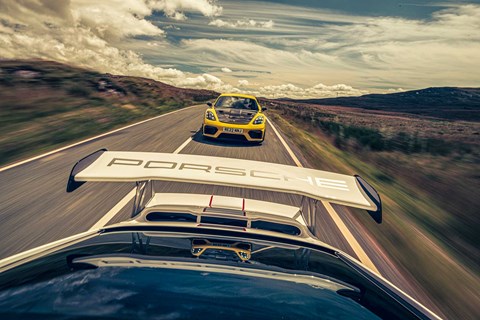
Controversial… It’s time to get re-acquainted with the 911 RS 4.0 and see if I’d just imagined that spellbinding steering feel.
The 4.0’s cabin has aged well in the last decade. Yes, there are lots of fiddly buttons down the centre of the dash where the 718 has a big colour screen, but the ambience is so similar to the newer car: fabric door-pulls, fixed bucket seats, alcantara and that thin, flat steering wheel. It’s bigger and more airy than the dark 718 cabin, but there’s an unmistakable RS lineage.
Start it up and it’s a shock to hear this revered engine rattle like a biscuit tin full of marbles – a noisy tickover is just one of the quirks of its racing DNA. Dip the firmly sprung clutch, find the notchy first gear, and you’re off. And yes, yes, YES! Oh God, I did NOT misremember it – half a mile up the road, I’m shaking my head in awe. It is sensational straight away, and the contrast is stark. How many people in the world will get straight out of the 718 Cayman GT4 RS and into a 911 GT3 RS 4.0? Not many, so you’ll have to take my word for it.
From the moment you start driving, the 4.0’s steering feels alive compared to the 718. It doesn’t have the same synthetic resistance to movement; instead it has an almost resinous looseness around the straight ahead, that stiffens as you put on the lock, but it feels completely authentic. And the whole time, the tiny jiggles and quivers in your hands, as those front tyres navigate the road surface, make it feel energetic and overflowing with information.
And the way the car moves, it feels so fluid, which is weird. When the 4.0 first came out, it was criticised (no, that’s too strong – it was politely ‘called out’) for being too stiff. But now, compared to the super-stiff 718, the older car feels like liquid flowing down the road. There’s so much movement: the bobbing front end, that you settle into a corner; then as you accelerate the torque floods out, the weight shifts, the rear squats and the tail feels like it’s driving you through the bend. Adjusting on and off the throttle, mid-corner, really changes the 4.0’s stance and trajectory, where the 718 just feels completely locked-down, almost inert in its consummate mastery.
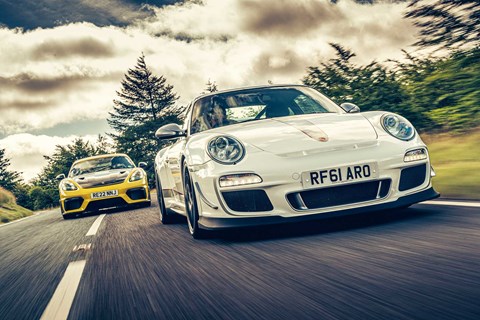
And that 4.0 Mezger engine… no it doesn’t rev to 9000rpm, but the 8500rpm limit is still crazy high, and to be honest there’s so much torque I find myself changing up at 6000 or 7000rpm, revelling in the free-flowing revs, the incredible howl. The noise is subdued by 718 RS standards, but pure 911 nirvana in its own right.
No, the joy in this car has nothing to do with chasing that redline – it’s to do with the sensations, the movement, the pin-sharp responses to everything you do, the way the drive is translated from foot to accelerator to engine and rear axle.
It is challenging. With everything moving around and your hand leaving the steering wheel to change the manual gearbox, the 4.0 is nowhere near as quick covering ground as the 718. Each gearchange requires thought and consideration: downshifts take time, with a very deliberate clutch, move to neutral, a measured heel-and-toe blip of the throttle, and then ease it into second for a tight apex… It’s so slow and needs so much care, compared to the instant snap-snap-snap shifts of the 718’s PDK.
A very analogue sports car: the 2011 Porsche 911 GT3 RS 4.0
But oh, the rewards! I am absolutely mesmerised by the 4.0; totally focused on the drive and what my hands and feet are doing. Can I get the line right? Can I get the downshift right? Can I keep this kinetic projectile – so full of speed and energy – on this narrow ribbon of tarmac? It feels like there’s much more at stake than in the 718 (yeah, about £300k more) – like an error could be just around any corner. The 718 makes you feel invincible (arguably dangerously so) while the 4.0 asks a lot, lot more of you.
I can’t drive it forever, though, so I switch back into the 718 GT4 RS and CAR’s James Taylor gets into the 4.0. He’s never driven one before and I’m keen to see what he thinks. We drive back the way we came, cross country in a rapid convoy, me in the 718 hard on his tail. It’s fascinating to watch the 911 at speed, from behind: I see it moving around, the balance shifting, I sense James’s extra caution on the brakes, imagine him concentrating on those gearshifts. It’s important to know, at this point, that James is a much more talented driver than I am. Important, because you need to understand what it means when I say I’m following him at seven or eight tenths. I’m barely thinking about what I’m doing, turning the 718’s wheel, hands fixed, shifting with the paddles, focusing as much on the 911 ahead as my own driving. The 718 is ridiculously accomplished.
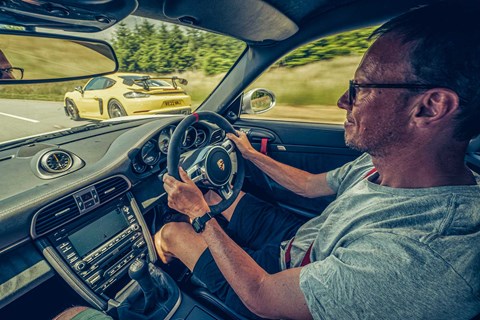
When we get to the end of the road and pull into a layby, James is grinning from ear to ear. Yes, he agrees, it is challenging. It needs so much more concentration and no, he didn’t see the redline either. But the feelings! The emotions! The way your brain engages with the car like you’ve plugged yourself into its chassis. It’s great to see someone else in awe too. It’s not just me.
There’s no doubt the GT4 RS is one of the most sensational cars to come out of Porsche in years. Compared to anything else on the road right now, it is a remarkable experience – for that noise alone. I’ll also concede that the launch back in March was on both road and track, and I think a lot of the plaudits came out of its playfulness on the circuit. And if I had to pick one of these two to take to a trackday and blitz everyone else with lap times, it would definitely be the 718.
But if Porsche is just chasing lap times and efficiency these days, I think that’s a shame. Because driving the 911 RS 4.0 on the road is once again a stark reminder that hydraulic steering in a performance car is better. It just is. Ask McLaren, the only company to stick with this ‘old school’ (better) way of connecting driver and front wheels.
The 4.0 is so full of tactile sensations it makes the 718 feel sterile, and the pursuit of pure speed is going nowhere. Every time I got a downshift right in the 4.0 and swept through a corner in third with the revs absolutely singing, I wanted to whoop. Isn’t that what this kind of car should be about? I just can’t believe any Porsche engineer would drive the 4.0 and think, ‘Hmm, could really do with all that vibration, movement and steering “noise” being filtered out.’ Surely they’d love it too? In which case, why not reproduce it? Build an RS for feel, not speed. A slightly slower, manual-’box Cayman RS with hydraulic steering and a limited production run of 600 cars.
Until that day, though, I’m afraid the 718 RS comes second in this test. Yes, it is amazing, and unlike the 4.0 you can actually buy one and it won’t cost you half a million quid. But measured on those driving qualities alone, I reckon Porsche peaked a decade ago. I say the 911 GT3 RS 4.0 isn’t just the ‘Best Fish and Chips in the World, 2011’ – it’s also the greatest Porsche, the greatest RS and arguably the best sports car ever built. Ever. See? Now I’ve gone and got carried away too.
More comparison tests by CAR magazine